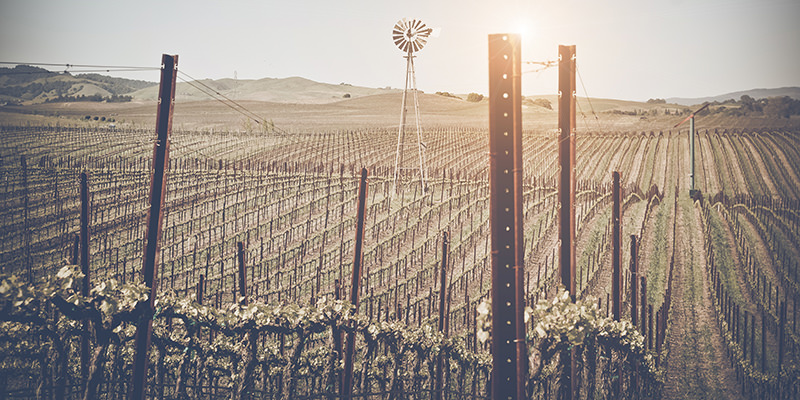Assuming everything stays below storm-level force, it’s hard not to love a good wind. Yeah, we said “wind,” as in moving air caused by the meeting of low and high pressure fronts. Seriously, how can we not geek out over wind? It cools us down on a hot day. It gives flags shape and makes chimes seem less pointless. And in just the right conditions, it makes us look really, really cool.
Another reason to love wind: wine. Among the many climatic factors that can bust or benefit the vineyard, wind has had a particular, and even mythical, influence in more than a few regions. Beyond giving the vineyard a romantic flutter every now and then, moving air can actually help to dry up moisture and prevent mildew on the vine. On a larger scale, it can even push away lazy, heavy clouds, letting more sunshine spill over the grapes, creating more sugar, yielding more alcohol, making us giddier (and so the dance continues).
Since wind is largely invisible but for its effects, we figured we should call out a few of the more prominent wine country winds, key players in the meteorological dance that keeps grapes growing and bottles (temporarily) full.
The Mistral
As far as famous winds go, the Mistral might be on the top of the list, and for good reason: the Mistral influences the climates of Provence, the Rhone valley region, and part of the Languedoc. That’s a lot of wine.
And while you might be imagining some kind of flirtatious breeze tickling its way over Provencal vineyards while soft accordion plays, the Mistral is not as romantic as its name sounds. In fact, it functions more like a janitor, pushing out clouds, mopping up moisture, and keeping the southeastern region meteorologically tidy and fresh. Although it’s caused by the collision of high- and low-pressure systems in the Bay of Biscay and the Gulf of Genoa (as in the salami), the Mistral mainly affects southeastern France, sweeping over parts of the region with serious force. Gusts can get as high as 60 miles per hour. And because it tends to dry things out—one of its nicknames, “mange-fange,” means the mud-eater—the Mistral can actually cause fires in the warmer seasons. At its kindest, however, it does keep parts of the Rhone, Provence, and Languedoc happy and scrubbed, which keeps wine flowing, which keeps us happy.
The Cape Doctor

The Cape Doctor is a local nickname for a set of seasonal South African winds (also, if less creatively, known as the South-Easter). If you can imagine a metaphorical wind giant with a lab coat, you’re halfway there; story has it the wind got its name for clearing away all manner of germs and nastiness in the atmosphere. In truth we think the cleaning metaphors are more apt, since, like the Mistral, the Cape Doctor is known for its ability to sweep away pollution and clear the skies in the Western Cape, where a majority of South African wine is made. (It’s also known for its ability to turn city streets into wind tunnels.)
Following through with the household tidiness metaphor, the Cape Doctor also creates something known as the “Table Mountain Table Cloth,” a reference to South Africa’s famously flat Table Mountain (ready for a Titan tea party any day of the week). The “table cloth” here is a nickname for the layer of moisture the Cape Doctor pushes up along the eastern slope of the mountain, encouraging vegetation. Most important for wine country are the gusts, which can reach 60 miles per hour or more at their pushiest, but also dry the region out, preventing grape rot and mildew. The Cape Doctor can also pick up a little cold from the Antarctic Benguela Current and whoosh it over the vineyards, giving a nice little chill (like a doctor with an ice-cold stethoscope).
The Petaluma Gap
OK, so technically speaking, the Petaluma Gap isn’t the name of a wind, but the name of an area that, among other things, is conducive to creating unique wind patterns within the larger Sonoma Valley region. (The term “gap” actually refers to a wind gap, meaning this is actually the opposite of wind.)
Basically a lowland area that stretches from the Pacific inward, the gap influences wind patterns in such a way that vineyards can flourish in the region. And they have—since the late 19th century. Areas within the gap tend to get some of the region’s famous fog, but by afternoon it’s sun and wind, a pattern that keeps grapes like Pinot Noir, Chardonnay, and Syrah generally happy. The gap is such a specific microclimate that there’s actually a Petaluma Gap Winegrower’s Association.
The Siroccos
If you’ve used the words “Nero d’Avola” or “Mt. Etna” in describing your wine habits, you like Sicilian wine (also if you’re a fan of Marsala, though those ranks aren’t as robust as they once used to be). Other factors arguably have more famous influence on Sicilian wines, for instance the volcanic soils of Mt. Etna, but the Sirocco winds can have an influence, too. And not necessarily a good one since they carry heat from the Sahara and gather humidity as they go, bringing storms in the fall and spring. But the heat from the wind can also keep soils dry. Like the Mistral and the Cape Doctor, the Sirocco winds can also blast pretty high, up to 50 miles per hour, a potential nuisance to exposed vineyards. And anyone wearing a wide-brimmed hat.

